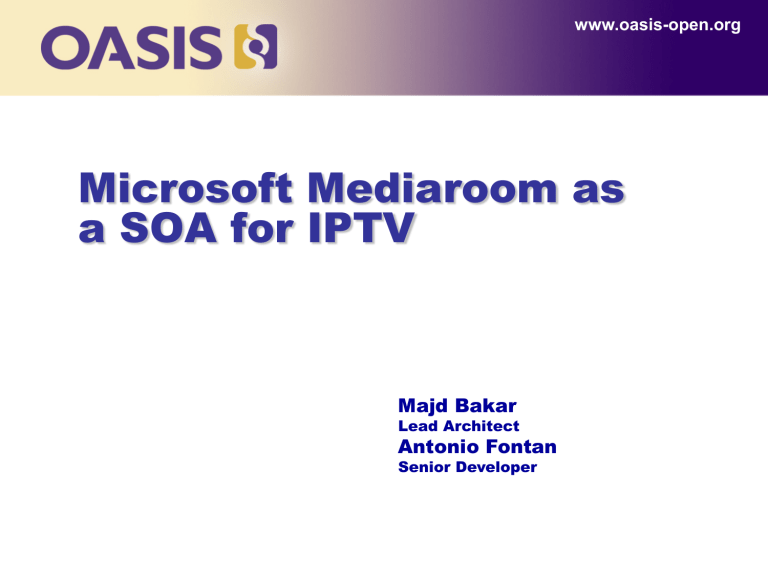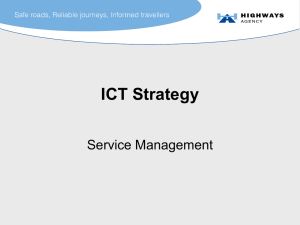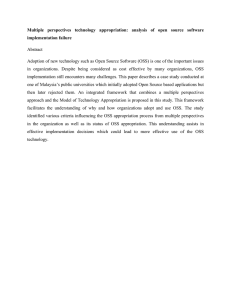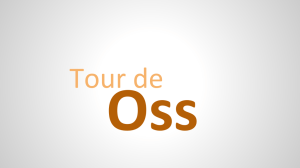
www.oasis-open.org Microsoft Mediaroom as a SOA for IPTV Majd Bakar Lead Architect Antonio Fontan Senior Developer www.oasis-open.org Agenda What is Microsoft Mediaroom High level Architecture System Interfaces Lessons Learned Future What is Microsoft Mediaroom Mediaroom is the brand name for Microsoft’s IPTV solution http://www.microsoft.com/tv It is an end to end platform for delivery of video over reliable IP networks based on commodity hardware IPTV Solution for Telcos Linear, on demand, and time-shifted content delivery over DSL networks Integrated content protection Rich and reliable meta-data for content discovery Extensible application framework Target Advertisement Rich data collection End to End IPTV solution 1 2 3 4 5 6 Content Acquisition Content Protection Service Management Subscriber Management Service Delivery Service Consumption A Complete Platform Encoders Content packaging Tools Rights Management Mediaroom Content Protection Meta-data Billing Events VOD STB Client Device Management Subscriber Validation PVR PC Client Linear TV OSS/BSS Subscriber Management Consumer Devices NPVR Customers Over 2,000,000 television sets More than 20 of the world's leading service providers: AT&T, BT, Deutsche Telekom, Reliance Communications, Swisscom,… http://www.microsoft.com/tv/Customers .mspx • Over 20 service providers worldwide • 14 commercially deployed • Over 2.0M TV sets and counting… High Level Architecture Broadcast Feeds VOD Assets Real-Time Encoders OSS/BSS Video Server OSS/BSS Backend Asset Ingestion Branch Office VOD Server Service Group Service Group Client Gateway Client Facing Servers Subscribers Service Group Mediaroom Set Top Boxes Interfaces Why SOA? Enables a highly decoupled, modular, and interoperable architecture Current interfaces based on Web Services To Mediaroom Operations Support Systems Business Support Systems Inside the Mediaroom system Backend to Branch Client/STB to server OSS/BSS Broadcast Feeds VOD Assets Real-Time Encoders OSS/BSS Video Server OSS/BSS Backend Asset Ingestion Branch Office VOD Server Service Group Service Group Client Gateway Client Facing Servers Subscribers Service Group Mediaroom Set Top Boxes OSS Interface for Telco Operations Support Systems Service and Channel Management System and Device Management Diagnostics Content meta-data for linear and ondemand … BSS Interface for Telco Business Support Systems Principal (devices, accounts, users, and subscriber groups) Management Rights Management Billing Management Offer Management … OSS/BSS SOAP based Web Services Transport level security Main issues: Scalability in bulk processing Interoperability problems normally related to versioning and highly coupled APIs Solution: Loosely coupled & Batch APIs / Asynchronous Server processing Client to Server Interface Broadcast Feeds VOD Assets Real-Time Encoders OSS/BSS Video Server OSS/BSS Asset Ingestion Backend Branch Office VOD Server Service Group Service Group Client Gateway Client Facing Servers Subscribers Service Group Mediaroom Set Top Boxes Client to Server Interface SOAP based Web Services Proprietary message-based security Main issues: Always needed data on the client XML processing is expensive in lowend hardware Solution: Spreading of client requests, lower call load, reduce serialization needs Backend to Branch Interface Broadcast Feeds VOD Assets Real-Time Encoders OSS/BSS Video Server OSS/BSS Asset Ingestion Backend Branch Office VOD Server Service Group Service Group Client Gateway Client Facing Servers Subscribers Service Group Mediaroom Set Top Boxes Backend to Branch Interfaces SOAP based Web Services Transport level security Main issues: Not many real-life problems experienced between backend and branch Current Status Great scalability numbers in commodity hardware Subscriber numbers increasing at a very high rate Mediaroom supports up to 8 TV sets with DVR AT&T The Recorded TV menu, which AT&T U-Verse Total Home DVR customers can access from any TV to playback their recordings. AT&T Upgrades DVR Service Company Uses Multiroom Viewing To Take On Verizon By ANDREW LAVALLEE September 9, 2008; Page B9 AT&T Inc.'s U-verse service will let subscribers watch recorded shows on as many as eight television sets, an upgrade intended to compete more effectively with rivals' digital-video recorders. The feature, often called multiroom or whole-home DVR, is already available in San Francisco and some nearby cities to subscribers of U-verse, which allows users to view Internet video as well as TV programming on their sets. It will be rolled out to the rest of the Bay Area this week and will be available nationwide by year end, said Rick Welday, AT&T's chief marketing officer. It will be free as part of a Uverse subscription, which costs from $44 to $99 a month. DVRs have become popular in millions of households because they make it easy for users to skip commercials and watch TV shows on their own schedule. They have also emerged as a way for phone, cable and satellite companies to compete for market share. AT&T has some ground to make up on its main rival, Verizon Communications Inc., whose FiOS TV service has more than double the subscribers -- 1.4 million, versus 549,000 for U-verse. AT&T said it plans to exceed one million subscribers by year end. While it is unclear why the average household would need to see a show on eight TV sets, that stat gives AT&T bragging rights; FiOS's version of the service allows for only seven connected TVs. The one TV set with the DVR will remain the only set that can record shows. A subscriber could record and start watching a show in his living room, then pause it and resume watching in his bedroom. As many as four TVs can watch recorded shows at the same time. TiVo Inc. allows customers to transfer recordings to another set, but each one must be equipped with a DVR, which it sells for $150 to $600. Dish Network Corp.'s multiroom DVR capabilities are limited to two TV sets, and DirecTV Group Inc. said its multiroom offering will be available in upcoming months. Lessons Learned (I) Web services used as RPC increased coupling and reduced agility. SOAP limitations(costly serialization effort) Trade off between well defined interfaces and change management/scalability Exposing/retrieving large resources Low end Hardware It is critical adding better control for accessing server resources Lessons Learned (II) Modeling unknown applications is hard Scalability impact due to incorrect granularity of the interface implementation Lack of understanding of scenarios Saying “Contract first” is not good enough Different ways of creating WSDL introduce lack of consistency OSS/BSS interfaces should be driven from the use-case scenarios for the application Future - Extensibility Better control of workflow: Improve asynchronous handling of requests Prioritization of calls Simplify access to resources to facilitate application extensibility Reduce the number of overall requests between end-points Future - Design Scenario Driven development Better tools (DSL, Domain Specific Language) to capture scenarios and contracts Patterns of usage of the platform are better understood now Emphasis on modeling Access profile Layering of interfaces Thank You & Questions




